NCERT Solutions | Class 7 Maths Chapter 10 | Practical Geometry

CBSE Solutions | Maths Class 7
Check the below NCERT Solutions for Class 7 Maths Chapter 10 Practical Geometry Pdf free download. NCERT Solutions Class 7 Maths were prepared based on the latest exam pattern. We have Provided Practical Geometry Class 7 Maths NCERT Solutions to help students understand the concept very well.
NCERT | Class 7 Maths
| Book: | National Council of Educational Research and Training (NCERT) |
|---|---|
| Board: | Central Board of Secondary Education (CBSE) |
| Class: | 7th |
| Subject: | Maths |
| Chapter: | 10 |
| Chapters Name: | Practical Geometry |
| Medium: | English |
Practical Geometry | Class 7 Maths | NCERT Books Solutions
You can refer to MCQ Questions for Class 7 Maths Chapter 10 Practical Geometry to revise the concepts in the syllabus effectively and improve your chances of securing high marks in your board exams.
NCERT Solutions for Class 7 Maths Chapte 10 Practical Geometry Exercise 10.1
Ex 10.1 Class 7 Maths Question 1.
Draw a line, say AB, take a point C outside it. Through C, draw a line parallel to AB using ruler and compasses only.Solution:
Steps of Construction :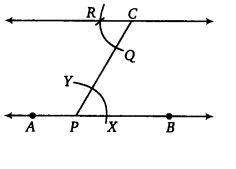
- Take any point P on the line AB.
- Take any point C outside AB and join CP.
- With P as centre, draw an arc cutting AB and PC at X and Y respectively.
- With centre C and the same radius as in step 3, draw an arc on the opposite side of the PC to cut the PC at Q.
- With centre Q and radius equal to XY, draw an arc cutting the arc drawn in step 4 at R.
- Join CP and produce it in both directions to obtain the required line.
Ex 10.1 Class 7 Maths Question 2.
Draw a perpendicular to l at any point on l. On this perpendicular choose a point X, 4 cm away from l. Through X, draw a line m parallel to l.Solution:
Steps of Construction: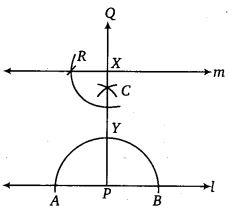
- Draw a line l and take any point P on it.
- With P as centre and any radius, draw an arc to intersect line l at A and B.
- With A as centre and radius greater than PA, draw in an arc.
- With centre B and the same radius, as in step 2, draw another arc to intersect the arc drawn in step 2 at C.
- Join PC and produce it to Q. Then PQ ⊥ l
- With P as centre and radius equal to 4 cm, draw an arc to intersect PQ at X such than PX = 4 cm.
- At X, make ∠RXP = ∠BPX.
- Join XR to obtain the required line m.
Validity: Since ∠BXP = ∠BPX and these are alternate angles, therefore, .XR || l, i.e., m || l and contain X such that PX = 4 cm and ∠XPB = 90°.
Ex 10.1 Class 7 Maths Question 3.
Let l be a line and P be a point on l. Through P, draw a line m parallel to l. Now join P to any point Q on l. Choose any other point R on m. Through R draw a line parallel to PQ. Let this meet l at S. What shape do the two sets of parallel lines enclose?Solution:
Steps of Construction :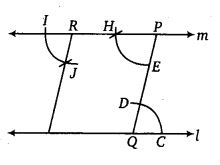
- Draw a line l and take any point P outside it.
- Take any point Q on line l.
- Join PQ.
- With a centre, draw an arc cutting l and PQ at C and D respectively.
- With centre P and the same radius as in step 4, draw an arc on the opposite side of PQ to cut PQ at E.
- With centre E and radius equal to CD,’ draw an arc cutting the arc of step 5 at F.
- Join PF and produce it in both directions to obtain the required line m.
- Take any point R on m.
- Through P, draw a line PS || PQ by following the steps already explained.
- The shape of the figure endorsed by these lines is a parallelogram RPQS.
NCERT Solutions for Class 7 Maths Chapte 10 Practical Geometry Exercise 10.2
Ex 10.2 Class 7 Maths Question 1.
Construct ∆XYZ in which XY = 45 cm, YZ = 5 cm and ZX = 6 cm.Solution:
Steps of Construction :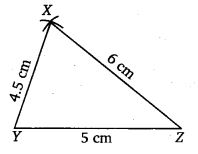
- Draw a line segment YZ = 5 cm.
- With Y centre and draw an arc radius cm.
- With Z as centre and draw another arc intersecting the arc radius = 6 cm, at X.
- Join XY and XZ to obtain the required triangle.
Ex 10.2 Class 7 Maths Question 2.
Construct an equilateral triangle of side 5.5 cm.Solution:
Steps of Construction :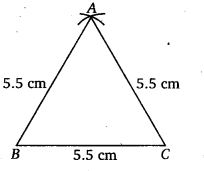
- Draw a line segment BC = 5.5 cm.
- With centre B and radius = 5.5 cm, draw an arc.
- With centre C and radius = 5.5 cm, draw another arc intersecting the arc drawn in step 2 at A.
- Join AB and AC to obtain the required triangle.
Ex 10.2 Class 7 Maths Question 3.
Draw ∆PQR with PQ = 4, QR = 3.5 cm and PR = 4 cm. What type of triangle is this?Solution:
Steps of Construction :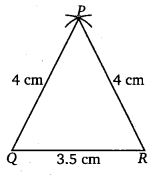
- Draw a line segment QR = 3.5 cm.
- With centre Q and radius = 4 cm, draw an arc.
- With R as centre and radius = 4 cm, draw another arc intersecting the arc drawn in step 2 at P.
- Join PQ and PR to obtain the required triangle. ∆PQR is an isosceles triangle.
Ex 10.2 Class 7 Maths Question 4.
Construct AABC such that AB = 2.5 cm, BC = 6 cm and AC = 6.5 cm. Measure ∠B.Solution:
Steps of Construction :- Draw a line segment BC = 6 c.m
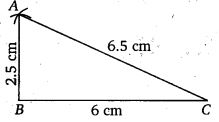
- With centre B and radius = 2.5 cm, draw an arc.
- With centre C and radius =6.5 cm, draw another arc intersecting the arc drawn in step 2 at A.
- Join AB and AC to obtain the required triangle.
On measuring, we find that ∠B = 90°.
NCERT Solutions for Class 7 Maths Chapte 10 Practical Geometry Exercise 10.3
Ex 10.3 Class 7 Maths Question 1.
Construct ∆DEF such that DE = 5 cm, DF = 3 cm and m ∠EDF = 90°Solution:
Steps of Constipation :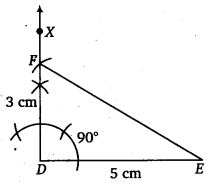
- Draw a line segmerit DE = 5cm.
- Draw ∠EDX = 90°.
- With centre D and radius = 3 cm, draw an are to intersect DX at F.
- Join EF to obtain the required triangle DBF.
Ex 10.3 Class 7 Maths Question 2.
Construct an isosceles triangle in which the lengths of each of its equal Sides is 6.5 cm find the angle between them is 110°Solution:
Steps of Construction :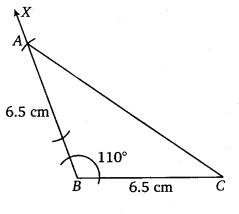
- Draw a line segment BC = 6.5 cm.
- Draw ∠CBX = 110°.
- With B as centre and radius = 6.5 cm, draw an arc intersecting BX at A.
- Join AC to obtain the required ∆ABC.
Ex 10.3 Class 7 Maths Question 3.
Construct ∆ABC with BC = 7.5 cm, AC = 5 cm and m∠C = 60°.Solution:
Steps of Construction :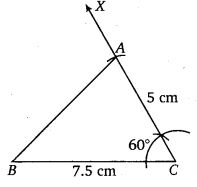
- Draw a line segment BC =7.5 cm.
- Draw ∠BCX = 60°.
- With C as centre and radius = 5 cm, draw an arc intersecting CX at A.
- Join AB to obtain the required ∆ABC.
NCERT Solutions for Class 7 Maths Chapte 10 Practical Geometry Exercise 10.4
Ex 10.4 Class 7 Maths Question 1.
Construct ∆ABC, given m∠A = 60°, m∠B = 30° and AB = 5.8 cm.Solution:
Steps of Construction :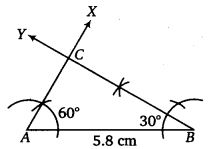
1. Draw a line segment AB = 5.8 cm.
2. Draw ∠BAX = 60°.
3. Draw ∠ABY, with Y on the same side of AB
such that ∠ABY = 30°.
Let AX and BY interest at C.
Then, ∆ABC is the required triangle.
Ex 10.4 Class 7 Maths Question 2.
Construct ∆PQR if PQ = 5cm, m ∠PQR = 105° and m ∠QRP = 40°.Solution:
Here, we are given the side PQ, ∠Q and ∠R. But to draw the triangle, we require ∠P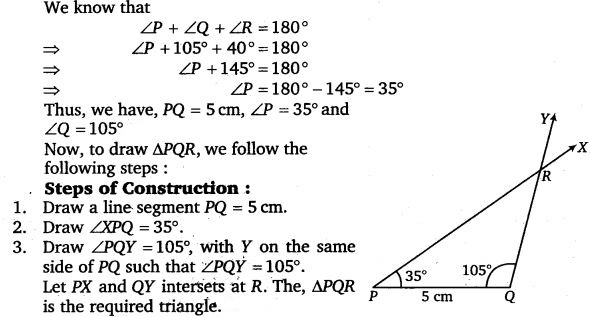
Ex 10.4 Class 7 Maths Question 3.
Examine whether you can construct∆DEF such that EF = 7.2 cm, m∠E = 110° and m∠F = 80°. Justify your answer.
Solution:
Since m∠E +m∠F = 110° + 80° = 190°, so the ∆DEF cannot be drawn as the’sum of all the angles of a triangle is 180°.NCERT Solutions for Class 7 Maths Chapte 10 Practical Geometry Exercise 10.5
Ex 10.5 Class 7 Maths Question 1.
Construct the. right-angled ∆PQR, where m∠Q = 90°, QR = 8 cm and PR = 10 cm.Solution:
Steps of Construction :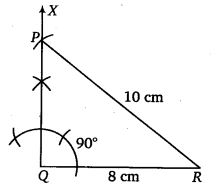
- Draw a line segment QR = 8 cm.
- Draw ∠XQR = 90°.
- With R as centre and radius =10 cm, draw an arc to intersect ray QX at P.
- Join RP to obtain the required ∆PQR.
Ex 10.5 Class 7 Maths Question 2.
Construct a right-angled triangle whose hypotenuse is 6 cm long and one of the legs is 4 cm long.Solution:
Steps of Construction :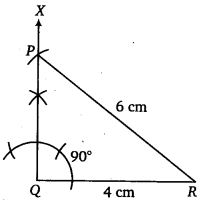
- Draw a line segment QR = 4 cm.
- Draw ∠XQR = 90°.
- With R as centre and radius equal to hypotenuse 6 cm, draw an arc to intersect ray QX at P.
- Join RP to obtain the required ∆PQR.
Ex 10.5 Class 7 Maths Question 3.
Construct an isosceles right-angled triangle ABC, where m ∠ACB = 90° and AC = 6 cm.Solution:
Steps of Construction :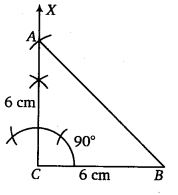
- Draw a line segment CB = 6 cm (∵ CB = AC = 6 cm)
- Draw ∠BCX = 90°.
- With C as centre and radius = 6 cm, draw an arc to intersect ray CX at A.
- Join BA to obtain the required triangle ABC.
NCERT Class 7 Maths
Class 7 Maths Chapters | Maths Class 7 Chapter 10
NCERT Solutions for Class 7 Maths
NCERT Solutions of Maths Class 7 Chapter-wise
Chapter-wise NCERT Solutions for Class 7 Maths
-
NCERT Solutions For Class 7 Maths Chapter 1 Integers
NCERT Solutions For Class 7 Maths Chapter 2 Fractions and Decimals
NCERT Solutions For Class 7 Maths Chapter 3 Data Handling
NCERT Solutions For Class 7 Maths Chapter 4 Simple Equations
NCERT Solutions For Class 7 Maths Chapter 5 Lines and Angles
NCERT Solutions For Class 7 Maths Chapter 6 The Triangles and its Properties
NCERT Solutions For Class 7 Maths Chapter 7 Congruence of Triangles
NCERT Solutions For Class 7 Maths Chapter 8 Comparing Quantities
NCERT Solutions For Class 7 Maths Chapter 9 Rational Numbers
NCERT Solutions For Class 7 Maths Chapter 10 Practical Geometry
NCERT Solutions For Class 7 Maths Chapter 11 Perimeter and Area
NCERT Solutions For Class 7 Maths Chapter 12 Algebraic Expressions
NCERT Solutions For Class 7 Maths Chapter 13 Exponents and Powers
NCERT Solutions For Class 7 Maths Chapter 14 Symmetry
NCERT Solutions For Class 7 Maths Chapter 15 Visualising Solid Shapes
NCERT Solutions for Class 6 to 12
-
NCERT Solutions for Class 6 All Subjects
NCERT Solutions for Class 7 All Subjects
NCERT Solutions for Class 8 All Subjects
NCERT Solutions for Class 9 All Subjects
NCERT Solutions for Class 10 All Subjects
NCERT Solutions for Class 11 All Subjects
NCERT Solutions for Class 12 All Subjects

Post a Comment
इस पेज / वेबसाइट की त्रुटियों / गलतियों को यहाँ दर्ज कीजिये
(Errors/mistakes on this page/website enter here)